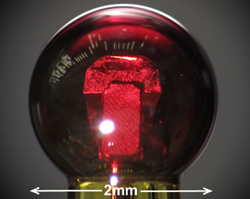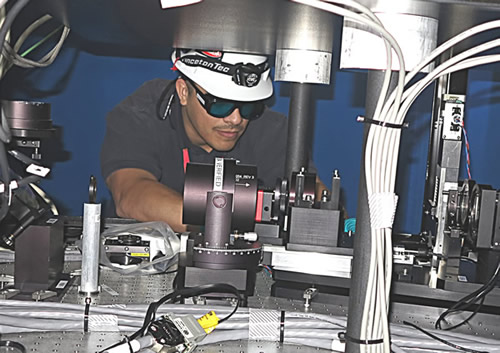NIF Status Update – 2013
A monthly report on experimental progress at the National Ignition Facility. For more information on NIF & Photon Science activities and accomplishments, see the Photons & Fusion Newsletter.
January
NIF Sets Records for Target Shots and Wavelength Changes
The NIF team completed a record 28 laser shots on targets in January, along with two shots without targets. January also saw a significant increase in NIF's experimental flexibility, as the team completed 40 laser wavelength changes – more than double the number in any previous month. Changing the laser wavelength by a few angstroms in different "cones" of laser beams enables researchers to adjust the amount of energy reaching different areas of the hohlraum targets.
This enhanced capability was largely made possible by the new AM (amplitude modulation) compensation diagnostics developed last year by a team led by Jean-Michel Di Nicola and Mark Bowers (see Photons & Fusion, July 2012), and feedback from laser diagnostics. Also contributing to the increased flexibility is NIF's laser performance operations model (LPOM), which allows for rapid and automated precision laser shot setups, including adjustments for amplifier gain and changes in shot wavelengths.
 Physicist Mike Shaw examines diagnostic data from a recent Polar Direct Drive Campaign shot.
Physicist Mike Shaw examines diagnostic data from a recent Polar Direct Drive Campaign shot.
New Year Begins with Equation-of-State Experiments
The NIF team completed the first experiment of 2013, a university-use ramp-compression equation-of-state (EOS) shot, on Jan. 2. An iron sample was gradually compressed to a pressure of eight megabars (eight million times Earth's atmospheric pressure, exceeding the pressure in Earth's core).
The experiment was part of a series aimed at providing clues to the formation and structure of planets as well as the exotic behavior of materials at ultrahigh densities. Knowing the equation of state, or the thermodynamic relationship between the energy content of a mass of material, its volume, and its temperature, is essential for determining how matter behaves at high energy densities. Use of the time-dependent ramp-wave compression technique is key to keeping the material relatively cool and solid to higher pressures than could be achieved with standard near-instantaneous shock-physics experiments.
In the Jan. 2 experiment, 176 NIF beams delivered 198 kilojoules (kJ) of ultraviolet (3ω) laser light to the drive hohlraum in a nearly 30-nanosecond ramp pulse. Excellent Velocity Interferometer System for Any Reflector (VISAR) data were obtained.
Another high-energy-density iron EOS experiment, on Jan. 21, tested ramp compression of four iron samples to eight megabars; 172 beams delivered 179 kJ of 3ω light to the drive hohlraum in a 28-ns pulse. The VISAR diagnostic again acquired good data.
 Multiple-exposure photograph of Cryogenic Operations technician Frank Cebreros testing the activation of the target shroud in the NIF cryogenic target positioner (CryoTARPOS) in preparation for the Jan. 6 tantalum EOS experiment. Two Y-shaped arms form a shroud around the cold target to protect it until they open five seconds before a shot. (Photo credit: Don Jedlovec).
Multiple-exposure photograph of Cryogenic Operations technician Frank Cebreros testing the activation of the target shroud in the NIF cryogenic target positioner (CryoTARPOS) in preparation for the Jan. 6 tantalum EOS experiment. Two Y-shaped arms form a shroud around the cold target to protect it until they open five seconds before a shot. (Photo credit: Don Jedlovec).
The team also conducted ramped tantalum EOS experiments at seven megabars for the High-Energy-Density (HED) Program on Jan. 6 and Jan. 10; 176 beams delivered about 140 kJ of 3ω light to the drive hohlraum in a ramp pulse to gradually compress the tantalum samples. Excellent VISAR data again were obtained.
On Jan. 3, the team conducted the first NIF EOS experiment with the goal of achieving pressures of more than a gigabar, or more than a billion times atmospheric pressure. A backlit germanium-doped plastic ball was imploded inside a hohlraum and diagnosed by a streak camera; 183 drive and eight backlighter beams delivered 1.25 megajoules (MJ) of 3ω light to the target with 412 terawatts (TW) of peak power. Excellent sphere implosion data were obtained.
This experiment was a collaboration with UC Berkeley's Roger Falcone and other researchers.
Three-Axis Keyhole Experiments Conducted
 Photo of the three-axis keyhole capsule picture shows the back of the VISAR cone with the two axis mirrors directing the beams to 45 and 90 degrees. The capsule is a masterpiece of engineering and assembly.
Photo of the three-axis keyhole capsule picture shows the back of the VISAR cone with the two axis mirrors directing the beams to 45 and 90 degrees. The capsule is a masterpiece of engineering and assembly.
On Jan. 10, the NIF team successfully fired NIF's first three-axis "keyhole" shock timing experiment. A sophisticated VISAR cone in the target capsule split the VISAR beam into three segments: one looking straight at the back wall, one looking "up" at the pole, and one looking at a 45-degree angle, allowing simultaneous acquisition of shock timing data in three axes.
All 192 NIF beams delivered 976 kJ of 3ω light in a 327-terawatt peak power pulse to the drive hohlraum containing a deuterium-filled target capsule.
The experiments are designed to measure x-ray drive asymmetries introduced early in the laser pulse. These asymmetries can grow during the implosion of the fuel capsule, causing asymmetries in both the shape and areal density of the fuel at stagnation. The asymmetries reduce the efficiency with which the imploding capsule converts its kinetic energy into thermal energy, resulting in lower hot-spot densities and pressures, and must be controlled to an acceptable level.
A second three-axis shock timing experiment was conducted on Jan. 20. All 192 beams delivered 1.16 MJ of 3ω light to the hohlraum with 327 TW of peak power. Good VISAR data were acquired in both experiments.
 (Left) Computer-aided design drawing of the three-axis keyhole target and VISAR cone. (Right) VISAR data from the Jan. 9 (top) and Jan. 20 experiments (top-to-bottom orientation is reversed in the lower image). The numbers in the upper image indicate the shock “breakouts” during the four-stage laser pulse.
(Left) Computer-aided design drawing of the three-axis keyhole target and VISAR cone. (Right) VISAR data from the Jan. 9 (top) and Jan. 20 experiments (top-to-bottom orientation is reversed in the lower image). The numbers in the upper image indicate the shock “breakouts” during the four-stage laser pulse.
Re-emit and Planar Ablator Experiments
On Jan. 11, the team conducted a "re-emit" experiment to evaluate x-ray drive symmetry in the early stages of the laser pulse. All 192 beams delivered 17 kJ of 3ω light to the hohlraum in a 2.5-nanosecond picket with 12.5 TW of peak power. Good data were acquired.
The first planar ablator DT keyhole experiment was conducted on Jan. 14. This is a new platform to evaluate the performance of different ablator materials. The experiment tested a planar, or "sandwiched," boron-carbide ablator attached to a quartz substrate; 192 beams fired one MJ of ultraviolet light to the drive hohlraum in a 407-TW peak power pulse.
Pace of Experiments Quickens at Month's End
The NIF Team conducted eight system shots on targets between Jan. 23 and Jan. 31. Here are some highlights:
- "Starburst" Experiment: On Jan. 23, the team conducted a keyhole shock timing experiment to test the effects of a "starburst" window in the hohlraum on the strength of the laser shocks. This experiment used a hohlraum without a starburst to compare shock velocities against the results of experiments conducted earlier using a starburst window. The starburst windows are used to acquire x-ray images of the deuterium-tritium layers during ignition shots, and are predicted to perturb the x-ray drive symmetry on the capsule a small amount until they close after about five nanoseconds (ns) into the laser pulse under the influence of the hohlraum x-ray flux. All 192 beams fired 1.17 MJ to the hohlraum in a 330-TW peak power pulse. Good VISAR diagnostic data were captured.
- Laser Entrance Hole Imaging: On Jan. 24, a high-energy-density experiment was conducted to measure time-dependent closure of the laser entrance hole (LEH) in a radiation-transport vacuum half-hohlraum. Eighty beams fired 358 kJ into the half-hohlraum in a 12-ns pulse, and a soft x-ray imaging camera captured images of the LEH. A tantalum pentoxide (Ta2O5) foam was placed on the opposite end of the LEH, similar to prior experiments. A VISAR reflected off the shock in the foam and was used to measure the breakout time. All data were successfully acquired.
- Warm Hohlraum Symcap: The team conducted a warm (non-cryogenic) symmetry capsule (symcap) shot on Jan. 25. This was the second experiment in a series to study the effect of gas fill composition on laser propagation and backscatter. On this shot, the hohlraum gas fill was neopentane (C5H12), and the laser power and energy were 370 TW and about one MJ. Excellent data were acquired.
- Polar Direct Drive Experiment: On Jan. 28, the NIF team conducted the second experiment of the Polar Direct Drive (PDD) Campaign on NIF (see December 2012 Status Update). Direct-drive experiments focus the laser beams directly on the target capsule instead of using a hohlraum to drive the capsule implosion. Images were acquired of an air-filled plastic capsule being imploded by 192 beams in PDD configuration close to direct-drive conditions. The campaign's goal is to establish an ignition-relevant PDD platform to study capsule energetics, drive symmetry and laser coupling. This experiment also marked the first use of a beryllium filter on a diagnostic inside the NIF target chamber. All 192 beams delivered 342.5 kJ of 3ω light to the capsule in PDD geometry with a peak power of 61 TW in a 5-ns shaped pulse. Excellent data were acquired.
- High-Energy Backlighter Test: A high-energy backlighter (HEBL) test using a tiny silver foil target driven by eight beams at high intensity (a one-nanosecond, 12-terawatt pulse) back-illuminating a resolution target was conducted on Jan. 31. Excellent data were obtained; preliminary analysis indicated a factor-of-two resolution improvement over the previous HEBL test.
 A hohlraum with a starburst window.
A hohlraum with a starburst window.
 Target Diagnostics Operator Miguel Munguia performs optical interferometer changes in the VISAR diagnostic for the Jan. 24 LEH image experiment.
Target Diagnostics Operator Miguel Munguia performs optical interferometer changes in the VISAR diagnostic for the Jan. 24 LEH image experiment.


 Digg
Digg
 del.icio.us
del.icio.us
 reddit
reddit
 Yahoo
Yahoo
 Google
Google
 Slashdot
Slashdot
 Technorati
Technorati


